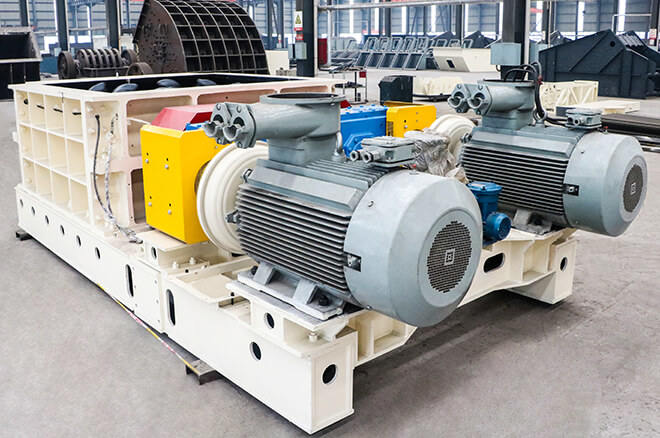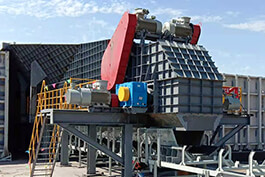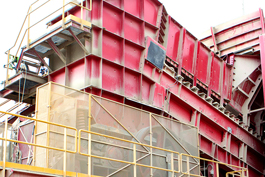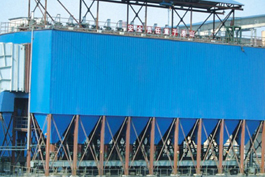The
apron feeder, as a core conveying equipment in the mining, metallurgy, and building materials industries, has a head wheel hub that is a key component for driving the chain and the material board. The manufacturing quality of the hub directly affects the stability, wear resistance, and service life of the equipment. This article, based on engineering practice, systematically expounds the key points of the manufacturing process of the head wheel hub.
Structure and material selection of apron feeder head wheel hub
1. Structural characteristics: The head wheel hub is usually a disc-shaped structure, consisting of the rim, spokes, and hub hole. The rim needs to fit with the chain pin shaft and withstand periodic impact loads; the spokes need to have sufficient rigidity to transmit torque; the hub hole is connected to the drive shaft through an interference fit.
2. Material selection: It is recommended to use high-strength alloy steel (such as 42crmo) or ductile iron (such as qt700-2). After quenching and tempering, 42crmo can achieve a hardness of hb280-320 and a tensile strength of ≥930mpa, suitable for heavy-duty conditions; ductile iron has a lower cost and good vibration damping and wear resistance.
Key manufacturing process analysis
1. Rough casting: Use resin sand casting, control the chemical composition of the molten iron (c: 3.6-3.8%, si: 2.2-2.5%), and eliminate shrinkage defects through the cold iron process. Forging: For high-strength requirements, use free forging or die forging, and after forging, perform normalizing treatment to refine the grain structure.
2. Machining: Rough machining: Reserve 2-3mm machining allowance, use a cnc lathe to machine the outer circle and end face, and control the shape and position tolerance ≤ 0.05mm. Fine machining: The tooth surface of the
apron feeder rim is processed by a cnc gear hobbing machine, with tooth profile accuracy reaching gb/t 10095.1-2008 grade 7; the hub hole is processed by honing, with dimensional accuracy reaching it6 grade and surface roughness ra ≤ 0.8μm.
3. Heat treatment strengthening: Quenching and tempering: For 42crmo material, quench at 850℃ and temper at 580℃ to obtain a uniform tempered sorbite structure and improve comprehensive mechanical properties. Surface hardening: Induction hardening is performed on the rim tooth surface, with a hardened layer depth of 3-5mm and hardness hrc45-50 to enhance wear resistance.
4. Surface treatment: Use hot-dip galvanizing or spray epoxy resin, with a coating thickness ≥ 85μm and a salt spray test time ≥ 1000 hours to prevent corrosion.
Quality control points
1. Dimension inspection: Use a three-coordinate measuring instrument to inspect key parameters such as the cylindricality of the hub hole and the cumulative error of the rim tooth pitch to ensure compliance with the drawing requirements.
2. Dynamic balance test: Perform dynamic balance correction on the finely machined hub, with an imbalance amount ≤ 15g·cm at a speed of 3000r/min.
3. Non-destructive testing: Use ultrasonic testing to detect internal defects, with a focus on checking for cracks in the transition zone between the spokes and the rim.
Typical problem solutions
1. Control of machining deformation: Use a phased machining strategy, perform aging treatment after rough machining to eliminate internal stress; use soft jaws during fine machining to reduce clamping deformation.
2. Prevention of tooth surface wear: Optimize tooth shape parameters (increase the root fillet radius) to reduce stress concentration; apply a molybdenum disulfide lubricating coating on the tooth surface to reduce friction loss.
The manufacturing of the
apron feeder head wheel hub requires a comprehensive consideration of material properties, process routes, and quality control. By optimizing casting/ forging processes, precision machining techniques, and surface strengthening treatments, the load-bearing capacity and service life of the hub can be significantly improved. In the future, the application of intelligent detection technology and additive manufacturing processes will further promote technological innovation in this field. This article, combining theory and practice, systematically expounds the manufacturing process of the head wheel hub and can serve as a reference for technical improvement in related enterprises. If you need to further discuss specific process parameters or conduct case analyses, more detailed technical support can be provided.


.jpg)








